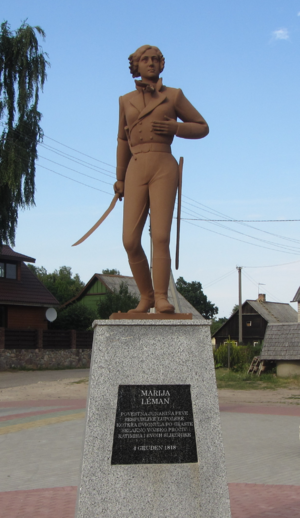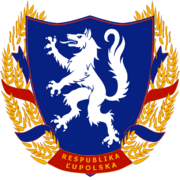Maria Lehman: Difference between revisions
No edit summary |
No edit summary |
||
| (4 intermediate revisions by the same user not shown) | |||
| Line 16: | Line 16: | ||
|birth_place = | |birth_place = | ||
|death_date = <!--{{death date and age|dYYYY|dMM|dDD|YYYY|MM|DD}}--> | |death_date = <!--{{death date and age|dYYYY|dMM|dDD|YYYY|MM|DD}}--> | ||
|death_place = [[Grast]], [[Luepola]] | |death_place = Near [[Grast]], [[Luepola]] | ||
|placeofburial = | |placeofburial = | ||
|placeofburial_label = | |placeofburial_label = | ||
|placeofburial_coordinates = <!--{{coord|LAT|LONG|display=inline,title}}--> | |placeofburial_coordinates = <!--{{coord|LAT|LONG|display=inline,title}}--> | ||
| Line 31: | Line 31: | ||
}} | }} | ||
'''Maria Lehman''' ({{lang-lupl|Marija Léman| | '''Maria Lehman''' ({{lang-lupl|Мария Лееман|l}}; {{lang-lupl|Marija Léman|}}) was a semi-legendary heroine of the [[Luepola|Luepolan]] [[Luepolan Revolution of 1818|Revolution of 1818]]. She is credited with having organized the revolt of the peasantry in the vicinity of [[Grast]] into the organized army that [[Igor Petrušić]] would come to command, and secure victory over [[Ratimir II]] with. Maria Lehman is usually portrayed as a peasant who became an experienced and skillful horsewoman. In some versions of her story, she is depicted as having been motivated to fight by the death of her husband; in others, she is simply one of a number of peasants. Most accounts of Lehman agree that she was killed in the [[Battle of Grast]]. Maria Lehman features prominently in Luepolan national symbology as an early patriot. Additionally, she is upheld globally as an early icon of {{wp|feminism}}, whose exploits contributed to the end of one of the more culturally backwards regimes of the era. | ||
Historians who remain skeptical of Lehman's existence point to the lack of corroboration of her account from official, pre-1822 sources under either Ratimir or Petrušić, or similar sources written by Lehman herself. Additionally, some historians point out that Petrušić may have seen the propaganda value of a heroine leading common men into battle, in particular as a way to inspire the support of Luepolan women for the [[First Luepolan Republic]]. Conversely, many contemporary sources from more lowly sources, such as those known to have fought as soldiers in the revolution, testify to her existence and give accounts of their interactions with her. The prevailing view of her among historians is that a Maria Lehman existed, but that her | Historians who remain skeptical of Lehman's existence point to the lack of corroboration of her account from official, pre-1822 sources under either Ratimir or Petrušić, or similar sources written by Lehman herself. Additionally, some historians point out that Petrušić may have seen the propaganda value of a heroine leading common men into battle, in particular as a way to inspire the support of Luepolan women for the [[First Luepolan Republic]]. Conversely, many contemporary sources from more lowly sources, such as those known to have fought as soldiers in the revolution, testify to her existence and give accounts of their interactions with her. The prevailing view of her among historians is that a Maria Lehman existed, but that her accomplishments are overstated, and that she was unlikely to have been the catalyzing figure for the formation of an organized army from the masses of revolting peasantry. | ||
{{Luepola Topics}} | {{Luepola Topics}} | ||
[[Category:Vasarden]] | [[Category:Vasarden]] | ||
[[Category:Luepola]] | [[Category:Luepola]] | ||
Latest revision as of 20:27, 31 December 2020
This article is incomplete because it is pending further input from participants, or it is a work-in-progress by one author. Please comment on this article's talk page to share your input, comments and questions. Note: To contribute to this article, you may need to seek help from the author(s) of this page. |
Marija Léman | |
|---|---|
 Statue of Lehman in Grast. | |
| Native name | Maria Lehman |
| Died | Near Grast, Luepola |
| Allegiance | |
| Years of service | 1818 |
| Memorials | TBD |
Maria Lehman (Luepolan: Мария Лееман; Marija Léman) was a semi-legendary heroine of the Luepolan Revolution of 1818. She is credited with having organized the revolt of the peasantry in the vicinity of Grast into the organized army that Igor Petrušić would come to command, and secure victory over Ratimir II with. Maria Lehman is usually portrayed as a peasant who became an experienced and skillful horsewoman. In some versions of her story, she is depicted as having been motivated to fight by the death of her husband; in others, she is simply one of a number of peasants. Most accounts of Lehman agree that she was killed in the Battle of Grast. Maria Lehman features prominently in Luepolan national symbology as an early patriot. Additionally, she is upheld globally as an early icon of feminism, whose exploits contributed to the end of one of the more culturally backwards regimes of the era.
Historians who remain skeptical of Lehman's existence point to the lack of corroboration of her account from official, pre-1822 sources under either Ratimir or Petrušić, or similar sources written by Lehman herself. Additionally, some historians point out that Petrušić may have seen the propaganda value of a heroine leading common men into battle, in particular as a way to inspire the support of Luepolan women for the First Luepolan Republic. Conversely, many contemporary sources from more lowly sources, such as those known to have fought as soldiers in the revolution, testify to her existence and give accounts of their interactions with her. The prevailing view of her among historians is that a Maria Lehman existed, but that her accomplishments are overstated, and that she was unlikely to have been the catalyzing figure for the formation of an organized army from the masses of revolting peasantry.
